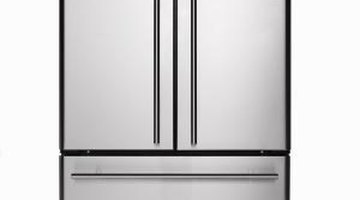What Can I Lay on Freezer Shelves to Keep Them From Icing Up?
Icing on freezer shelves is indicative of a cooling problem with the appliance. Sometimes the ice accumulation is a result of a freezer malfunction, but it can also be the result of improper operation. There are products on the market that claim to stop freezer icing, but the effectiveness of these items has not been confirmed. Frigidaire actually advises against placing any sort of lining on the freezer shelves. However, troubleshooting the cause of the ice accumulation, and making simple adjustments, may resolve the issue and allow the freezer to once again operate at its maximum efficacy.
Adjust the Temperature

Adjusting the temperature of your freezer may keep your freezer shelves from icing up. The temperature should be set between 0 and 5 degrees and you can use a thermostat to routinely check the freezer’s temperature for accuracy. Also, West Virginia University warns that if the ice cream in your freezer is not frozen solid, the temperature is too high.
Clean Condenser Coils
Cleaning the condenser coils can also alleviate icing on freezer shelves. The condenser coils can collect dirt, hair and other debris, which will negatively affect their ability to maintain the freezer’s recommended temperature. Use a condenser brush or a vacuum cleaner to remove dirt accumulations.
Defrost Evaporator Coils
Defrosting the evaporator coils can also prevent your freezer shelves from icing up. If frost and ice accumulate on the evaporator coils inside of the freezer, airflow will be limited, resulting in ice on the freezer’s shelves, ceiling, walls and floor. If this is the case, take everything out of the freezer, turn the refrigerator’s thermostat off, and leave the doors open for one to two days. Check the drip pan to ensure it does not overflow.
Evaluate Defrost Issues
After defrosting the freezer, turn the thermostat back to its normal temperature. If it is a self-defrosting freezer, and it begins to cool effectively, the self-defrost operation is malfunctioning. The issue may be the defrost timer, the defrost heater, the defrost thermostat or the refrigerant level may be low. A refrigerator repairman can troubleshoot self-defrost issues.
Maximize Door Efficiency
Ensuring that the door opens and closes properly can also help you avoid icy shelves. Close the door with the level of force that you would normally use, while observing it to see if the door closes completely. If it doesn’t, you may need to exert more force when shutting the door. Also, check the inside of the freezer to see if any objects are protruding out and hindering the door from closing firmly. In addition, examine the door seal to ensure that it is not gummy or dirty, which would prevent it from closing. If the door doesn’t close properly, the freezer will not maintain the correct temperature.
Purchase an Antifrost Freezer Mat
Using an antifrost freezer mat may help reduce ice on your freezer shelves. Generally, these antifrost freezer mats can be placed on the shelves or floor of the appliance. The insulated foam in the mats prohibits frost and ice from forming, and makes the freezer function more efficiently.
Other Considerations
Frigidaire warns against using aluminum foil as well as wax paper or paper towels on the shelves of the freezer. Lining the shelves hinders air circulation, which leads to icy build-up. You'll want to organize the freezer’s contents so you know where everything is located to reduce the frequency and length of time the freezer door is open. Repeated and extended door openings decrease the cooling operation.
References
Writer Bio
Terri Williams began writing professionally in 1997, serving as media manager for a large nonprofit organization where she also edited books and created promotional content. She has written extensively on business communication, ethics, leadership, management, education and health. Williams has a Bachelor of Arts in English from the University of Alabama at Birmingham.
Photo Credits
- Ryan McVay/Photodisc/Getty Images
More Articles



